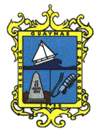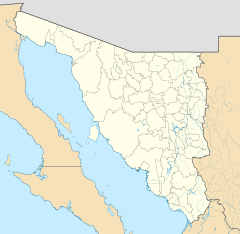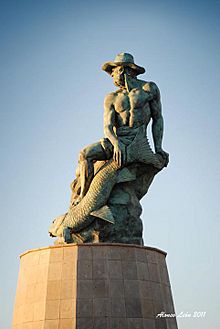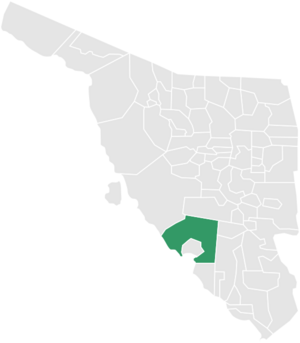Guaymas facts for kids
Quick facts for kids
Guaymas, Sonora
|
||
|---|---|---|
| Heroica Guaymas de Zaragoza | ||
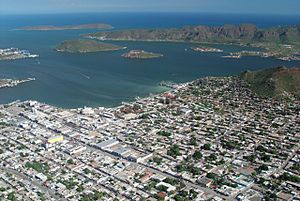
Aerial view of Guaymas
|
||
|
||
| Country | ||
| State | Sonora | |
| Founded | 1769 | |
| Municipal Status | 1825 | |
| Area | ||
| • Total | 12,206.18 km2 (4,712.83 sq mi) | |
| Elevation
(of seat)
|
10 m (30 ft) | |
| Population
(2005) Municipality
|
||
| • Total | 134,153 | |
| • Seat | 101,507 | |
| Time zone | UTC-7 (Pacific (US Mountain)) | |
| • Summer (DST) | UTC-7 (No DST) | |
| Postal code (of seat) |
85400
|
|
| Area code(s) | 622 | |
| Website | guaymas.gob.mx | |
Guaymas (pronounced WAI-mas) is a city in the state of Sonora, in northwestern Mexico. It's located in the southwest part of the state. The city is about 134 kilometers (83 miles) south of Hermosillo, the state capital. It's also about 389 kilometers (242 miles) from the U.S. border.
Guaymas is mainly an industrial port. It is the most important port for the state of Sonora. The city is famous for its yearly carnival, which has been celebrated since 1888. Close by, San Carlos and its beautiful beaches are popular places for tourists to visit.
Contents
Guaymas: A Look at Its Past
Before Europeans arrived, the Guaymas Bay area was home to the Guaymas, Seri, and Yaqui tribes. In 1539, two Spanish ships came to the bay. They were led by Francisco de Ulloa, who called the area "the port of ports."
Small Jesuit missions were started in the 1610s and 1620s. The Jesuits founded eight mission villages with the Yaqui people. The Seri tribe strongly fought against these European settlements until 1769.
In 1701, a Jesuit mission called Loreto was built inland from Guaymas Bay. To get supplies by ship, the Jesuits built another small mission on the bay. It was named San José de Guaymas. The Seri people often attacked this mission, so it had to be rebuilt many times. This mission was finally abandoned in 1759.
In 1767, the Spanish government ordered a big military operation. Its goal was to control the Seri and Pima tribes. After this, the Spanish built a fort in Guaymas. Today, no parts of this fort remain. However, the San José mission site is marked by a church.
Guaymas was officially declared a city in 1769. But no colonists settled there until the early 1800s.
In the early 19th century, Guaymas began to grow. In 1811, ships were allowed to trade there. Guaymas became an important stop for travelers by sea. The first commercial goods arrived in 1827. As more European-Mexicans moved in, the native Guaymas people moved away. They eventually became part of other groups.
The port became a municipality in 1825. During the Mexican–American War, American warships captured the town. It stayed in U.S. hands from 1847 to 1848.
In the mid-1800s, Guaymas faced attacks from unauthorized military groups. These groups, called filibusters, tried to cause rebellion. One such attack was by a French group in 1854. They wanted to control all of Sonora. But the port was successfully defended by José María Yáñez. The French leader was executed soon after.
The Mexican government made Guaymas a city in 1859 for its brave defense. In 1935, Guaymas received the title of "heroic city" for this same event. The city's official name, Guaymas de Zaragoza, was approved in 1862. In 1865, French ships attacked again during the Second French intervention in Mexico. The French occupied the city until 1866.
By 1890, the city had 10,000 people and was doing well. The yearly carnival tradition started then and continues today.
On October 4–5, 1911, a big hurricane hit Guaymas. About 500 people in the city and nearby areas died.
During the Mexican Revolution, a new type of attack happened near Guaymas. In 1913, rebel forces used an aircraft to bomb enemy ships in the bay. This was the first time a naval target was bombed from the air.
Modern port facilities were built in 1925 for the Mexican navy. Guaymas' importance as a port grew in the 1950s and 1960s. New piers and facilities were added for oil and grain export. A ferry service to Santa Rosalía, Baja California Sur began in 1972. In the 1980s, private companies built more port facilities.
Guaymas' Natural Surroundings
The municipality of Guaymas is located on the Gulf of California. It is also on the western edge of the Sonoran Desert. The area has a hot, dry climate and 117 kilometers (73 miles) of beaches.
Climate and Weather
Guaymas has a desert climate. This means it has hot summers and warm winters. Most of the rain falls during the monsoon season, from July to September.
| Climate data for Guaymas, Sonora (normals 1951–1980, extremes 1951–2000) | |||||||||||||
|---|---|---|---|---|---|---|---|---|---|---|---|---|---|
| Month | Jan | Feb | Mar | Apr | May | Jun | Jul | Aug | Sep | Oct | Nov | Dec | Year |
| Record high °C (°F) | 33.5 (92.3) |
36.6 (97.9) |
39.1 (102.4) |
40.6 (105.1) |
41.5 (106.7) |
42.5 (108.5) |
42.0 (107.6) |
41.9 (107.4) |
42.3 (108.1) |
41.1 (106.0) |
35.0 (95.0) |
32.5 (90.5) |
42.5 (108.5) |
| Mean daily maximum °C (°F) | 23.9 (75.0) |
24.6 (76.3) |
26.1 (79.0) |
28.5 (83.3) |
31.9 (89.4) |
34.2 (93.6) |
35.5 (95.9) |
35.4 (95.7) |
35.3 (95.5) |
32.5 (90.5) |
27.7 (81.9) |
24.0 (75.2) |
30.0 (86.0) |
| Daily mean °C (°F) | 18.5 (65.3) |
19.3 (66.7) |
20.9 (69.6) |
23.4 (74.1) |
26.3 (79.3) |
29.5 (85.1) |
31.2 (88.2) |
31.2 (88.2) |
30.9 (87.6) |
27.8 (82.0) |
22.5 (72.5) |
19.2 (66.6) |
25.1 (77.2) |
| Mean daily minimum °C (°F) | 13.7 (56.7) |
14.3 (57.7) |
15.6 (60.1) |
18.0 (64.4) |
20.9 (69.6) |
24.9 (76.8) |
27.6 (81.7) |
27.3 (81.1) |
27.0 (80.6) |
23.2 (73.8) |
17.9 (64.2) |
14.4 (57.9) |
20.4 (68.7) |
| Record low °C (°F) | −1.5 (29.3) |
−1.2 (29.8) |
4.6 (40.3) |
6.7 (44.1) |
10.5 (50.9) |
14.2 (57.6) |
10.5 (50.9) |
12.1 (53.8) |
14.7 (58.5) |
10.3 (50.5) |
4.0 (39.2) |
1.0 (33.8) |
−1.5 (29.3) |
| Average precipitation mm (inches) | 15.2 (0.60) |
6.3 (0.25) |
2.9 (0.11) |
0.8 (0.03) |
1.9 (0.07) |
0.7 (0.03) |
46.1 (1.81) |
69.7 (2.74) |
35.0 (1.38) |
14.6 (0.57) |
10.3 (0.41) |
14.7 (0.58) |
218.2 (8.59) |
| Average precipitation days (≥ 0.1 mm) | 2.20 | 1.20 | 0.92 | 0.16 | 0.25 | 0.54 | 5.95 | 7.30 | 3.21 | 2.12 | 1.33 | 2.00 | 27.18 |
| Average relative humidity (%) | 51 | 47 | 46 | 43 | 46 | 55 | 64 | 66 | 62 | 53 | 53 | 51 | 53 |
| Mean monthly sunshine hours | 207.2 | 216.1 | 230.2 | 251.8 | 291.6 | 302.4 | 246.5 | 241.2 | 237.7 | 253.7 | 219.5 | 200.4 | 2,898.3 |
| Source 1: Colegio de Postgraduados | |||||||||||||
| Source 2: Servicio Meteorológico Nacional | |||||||||||||
Exploring the City of Guaymas
Guaymas is a busy port city known for industry and shrimp fishing. It also has many interesting historical sites. The old buildings in the city center show a mix of Neoclassical and Moorish styles.
The city has two main plazas, or squares. One is called 13 de Julio Plaza. It's sometimes called the "lazy men's plaza" because many people relax there. In this plaza, there's a monument that remembers General José María Yáñez. He defended Guaymas against a French attack in 1854. The city's main church, San Fernando, built in the 19th century, faces this plaza.
The other main plaza is the Plaza de los Tres Presidentes (Plaza of the Three Presidents). It has statues of three former Mexican presidents who were from near Guaymas: Plutarco Elías Calles, Adolfo de la Huerta, and Abelardo L. Rodríguez. Next to this plaza is the Municipal Palace. There's also a small pier with the Statue of the Fisherman. This statue is a symbol of the city.
Other important places include the old Bank of Sonora building, with its grand front. There's also the old jailhouse, built in 1900. The Casa de las Conchas (House of Shells) has a large collection of shells. The Casa de Cultura (Cultural Center) offers art classes.
For older students, there are colleges like the Instituto Tecnológico de Guaymas. Baseball is a very popular sport here. The local team is called the Ostioneros.
Guaymas has an international airport. This makes it easy for people to visit. The city's food mixes seafood and beef dishes. You can find tasty fish tacos and carne asada (grilled meat).
The Colorful Carnival of Guaymas
Guaymas hosts one of Mexico's biggest Carnival celebrations. It's also one of the oldest carnivals in the country. This yearly event starts on the Thursday before Ash Wednesday. It ends at midnight when Lent begins.
Many events happen in different places. The big parade with floats lasts several days. The Carnival starts with the Quema del malhumor. This means "Burning of Bad Mood." An effigy (a dummy) of someone or something that people are unhappy with is burned. Each year, the effigy is different. In 2009, it was of a singer who sang the national anthem poorly.
Other main events include concerts by famous artists. There's also the election of the Carnival King and Queen.
The Carnival tradition in Guaymas began after a time of peace and growth in Mexico. Many European immigrants came to Guaymas. They brought the idea of celebrating Carnival like in Europe. The first Guaymas Carnival was in 1888. The first King and Queen were paraded through the streets. The event ended with a grand ball.
At first, only the upper classes mainly took part in the Carnival. The public watched the parade. But the most important events were private balls. This changed after the Mexican Revolution. The city wanted to keep the Carnival going. The event became more public, with people dressing in costumes in the 13 de Julio Plaza. It attracted visitors from nearby cities.
By the 1960s and 1970s, the Carnival became a huge event for everyone. Many visitors came to the city. The celebration moved to the larger Plaza de los Tres Presidentes. This allowed for carnival rides and concerts. Masks were later banned because of violence. Today, the Queen is chosen by popular vote. The King is called the Rey Feo (Ugly King).
Guaymas Municipality: Land and Life
The city of Guaymas is the main governing center for over 1,500 other communities. Some of the larger communities include Bahía San Carlos, Pueblo Vícam, and Pótam. The municipality covers a large area of 12,206.18 square kilometers (4,712.83 sq mi). Out of its total population of 134,153, about 101,502 people (75%) live in the city itself.
The municipality borders other areas like Cajeme and Hermosillo. To the west is the Gulf of California. Most of the land is flat and has 175 kilometers (109 miles) of coastline. Along the coast, there are important bays like Guaymas, Lobos, and San Carlos. These bays have most of Sonora's piers.
The area has a hot, dry climate. Temperatures can reach 50°C (122°F) in summer. From June to October, ocean temperatures are warm. Much of the land is covered with mesquite trees and cactus. It is also home to the endangered California Fan Palm. Desert animals like the desert tortoise, puma, and rattlesnakes live here.
Economy and Jobs
Fishing is the most important job and source of money in Guaymas. Many people work in catching, processing, and selling fish. Guaymas produces 70% of all the fish in Sonora state. The main types of fish caught are sardines, shrimp, and squid. Shrimp is especially valuable in the international market.
Farming here mostly uses irrigation from wells and a dam. Farmers grow wheat, soybeans, corn, and cotton. They also grow some fruits like pumpkin and papaya.
Raising livestock is also important. Cattle are the most common, followed by goats. There are also pigs and chickens.
The manufacturing industry is growing. Many factories, called maquiladoras, have opened here. They make parts for aerospace engines, cars, and medical devices. Construction related to the port also provides many jobs. Some mining happens, mostly for graphite.
Tourism and Fun Activities
Guaymas offers many fun things for tourists to do. You can enjoy golf, snorkeling, and sport fishing. Other activities include horseback riding, ecotourism tours, cycling, diving, and kayaking.
The beach area is very popular with visitors from Arizona and Sonora. San Carlos (Mexico) is a key spot for sportfishing. It has modern piers and many kinds of fish like sailfish and marlin. A fishing tournament is held there every July. San Carlos also has an aquarium with dolphins and sea lions. A famous peak in San Carlos is called Tetacawi, which looks like two horns.
Other sports you can try include kayaking, sailing, and jetskiing. You can also go snorkeling and scuba diving. San Pedro Nolasco Island is a great place for snorkeling and seeing sea lions.
The Bacochibambo or Miramar Bay also attracts tourists. This bay has a pearl farm, the only one of its kind in the Americas. The pearls come in many colors like grey, gold, and black.
On land, you can visit the Sahuaral Desert, which is close to Guaymas. It has a very tall cactus that is about 500 years old. The Barajitas Canyon is a natural reserve. It has three different ecosystems and is a special place for the Seri Indians. You can only reach this canyon by boat.
The most famous festival in Guaymas is the Carnival, held every February since 1888. Another festival is the Bermejo Sea festivities in July. These celebrate the Battle of Guaymas.
Guaymas also has the Sonora Dolphinarium. Here, you can get dolphin-therapy services. Tourism creates over 8,000 jobs in Guaymas. The city has many hotels, motels, and guesthouses.
Travel and Communication
The municipality of Guaymas has a good road network. The main road is Federal Highway 15. There are also many smaller rural roads.
It has a railway line and an international airport. The port of Guaymas has many docks for ships. For public transport, there are bus services.
Guaymas has all the modern communication services. This includes mail and telegraph services for smaller towns.
Space Tracking Station
A space observation station is located about 10 kilometers (6 miles) east of Empalme, Sonora. It is run by the Mexican Space Agency. This station was a key part of NASA's worldwide Manned Space Flight Network.
Built in 1961, the Guaymas Tracking Station helped track American manned space flights. This included missions in the Mercury, Gemini, and Apollo programs, up to Apollo 13. The U.S. stopped using it in 1970. Some equipment was left for Mexican space activities. Local sources say the station was later used as a warehouse.
People and Population
Different Groups of People
Many people in Guaymas speak an indigenous (native) language. About 8% of the total population, or 11,394 people, speak an indigenous language. The most common language is Yaqui Language. About 94.6% of indigenous speakers use Yaqui.
How the Population Has Grown
In 2010, the city of Guaymas had 113,082 people. The whole municipality has about 149,299 people living in its many communities. Besides the city of Guaymas, other important communities include Vícam with 9,364 people, Pótam with 6,417, and San Carlos with 2,264.
Sister Cities
Guaymas has special connections with other cities:
See also
 In Spanish: Heroica Guaymas para niños
In Spanish: Heroica Guaymas para niños


